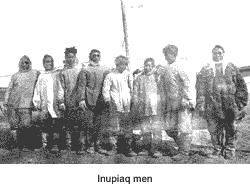Traditional Arctic culture resembles a scattered family on account of social, linguistic, economic and spiritual similarities across more than 5,000 miles of Arctic coast and tundra. This culture region borders the Subarctic culture region. The Arctic forebears probably trekked from Eurasia eastward across Alaska and northern Canada to Greenland.
Arctic peoples learned to adapt to one of the harshest environments on Earth and subsisted for millennia on resources drawn from sea and land. Previous to the advent of European influence, numerous bands came into routine contact, principally for trade.
In Alaska, these peoples are known as Inupiaq and Yup'ik (Eskimo); in Canada and Greenland, they are Inupiaq and Kalaalit (Inuit), respectively.* Non-Arctic peoples racially and ethnically related to the Eskimos are the Aleuts.
Inupiaq of Alaska
These natives can be included among those peoples who live closest to the top of the world. Although their language is similar to that of the Yup’ik, the Inupiaq are more closely related to their counterparts in Canada and Greenland. Their main language (Inupiaq) spans from Norton Sound on the west coast of Alaska, across northern Alaska to Canada and Greenland, where it is called Inuktitut. Although there are dialectical variations, Inupiaq Alaskans and Greenlanders can communicate with each other.
Much of the year, Inupiaq tundra territory is frozen and ocean ice is continuous from the northern Alaskan shore across the North Pole. Skilled hunters, these short, weather-hardened people possess an intuitive grasp of their environment and a profound regard for the sea, land and living things.
 Traditionally, Inupiaq people hunted caribou, musk-ox, polar bear, seal, walrus and whales, and fished for Arctic char, cod and salmon. They also foraged for berries and other vegetation during the short summer season. Traditional trade and bartering could span hundreds of miles.
Traditionally, Inupiaq people hunted caribou, musk-ox, polar bear, seal, walrus and whales, and fished for Arctic char, cod and salmon. They also foraged for berries and other vegetation during the short summer season. Traditional trade and bartering could span hundreds of miles.
Before contact with Europeans, Inupiaq people built boats of walrus skin on wooden frames. There were no trees, but driftwood was obtainable.
A whale hunt traditionally called for strong collaboration among participants. Several boats traveled together and if a crew harpooned a whale, the other crews would come to their aid. If a whale was harvested, the captain and crew that first struck it received choice cuts. Everyone in the village helped divide and share the huge mammal, whose blubber was prized.
Yup'ik of Alaska
The ancestors of the Yup'ik people likely arrived in the third or final migration from Asia about 11,000 years ago, at the end of the last Ice Age.
The Yup'ik homeland is typically flat, treeless tundra glinting in the summer with a myriad of small lakes. The Yup'ik turned to the ocean and rivers for sustenance. Foodstuffs were kept in caches underground.
People lived in houses constructed of wood and whalebone with walrus skins for the roof and sides. Glass windows did not exist; the inside was lighted with bowl-shaped lamps fashioned from clay or carved stone, fueled by seal oil.
Diseases came with the encroachment of 19th century European and Russian explorers, fur traders and settlers. Yup'ik villages sustained disastrous epidemics of influenza, smallpox and tuberculosis.
Inupiaq of Canada and Greenland
These Inupiaq closely resembled their counterparts in Alaska. During long journeys, some Inupiaq made dome-shaped winter houses from snow blocks. These were nonexistent in Alaska and unusual in Greenland. The Inupiaq Greenlanders were highly mobile and adaptive, and until recent years traveled by dog team across the ice to Canada.
Kalaalit of Greenland
The Kalaalit call their homeland Kalaalit Nunaat, "The Land of Humans." A number of words from their language have been assimilated elsewhere, such as anorak, igloo, nunatak, umiak and kayak.
The Kalaalit were masters in the construction and use of the eminently seaworthy kayak. Its top sported a small round opening that the paddler stoppered with his midriff when he squeezed in. This precluded water from entering the boat, even in heavy weather. If the kayak overturned, it was simple to spin it upright with the paddle, like an aircraft barrel roll.
The Kalaalit believed in Tupilak, a malignant presence, which they typically depicted with whale and walrus ivory or limestone carvings. It was common belief that an adversary could be dispatched by sending him such a carving.